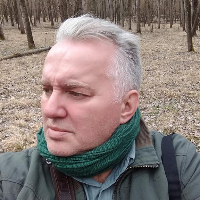Preprint
Article
The Use of Herbicides to Early Spring Broadleaved Weed Control during Seedling Dormancy in the Regenerated Pedunculate Oak Forests
Altmetrics
Downloads
88
Views
20
Comments
0
A peer-reviewed article of this preprint also exists.
Submitted:
20 October 2023
Posted:
20 October 2023
You are already at the latest version
Alerts
Abstract
In regenerated oak forests, weeds are present throughout the year, the ones appearing in early spring representing a major problem. Hence, the aim of this study was to examine herbicides for early spring broadleaved weed control in the regenerated oak forests while the seedlings are in a dormant stage. During 2019 and 2020 two experiments were set up in regenerated pedunculate oak forests with 2-yar and 3-year-old seedlings and two herbicides were applied in two doses: fluroxypyr at dose 360 g a.i. ha-1 and 540 g a.i. ha-1 and clopyralid at dose 100 g a.i. ha-1 and 120 g a.i. ha-1. The results from the two-year investigations showed that fluroxypyr and clopyralid significantly reduced early spring broadleaved weeds in the regenerated pedunculate oak forests but both doses of fluroxypyr provided greater control of presented weeds than the applied doses of clopyralid. The manual weeding reduced broadleaved weeds in experiments, but that method did not have a long-term effect on the reduction of weeds. Applied doses of herbicides fluroxypyr and clopyralid did not cause phytotoxicity symptoms in dormant oak seedlings. All investigated treatments significantly reduced fresh broadleaved weed biomass compared to the control. Generally, it can be concluded that fluroxypyr and clopyralid can be successfully used for control of many early spring broadleaved weeds in the regenerated pedunculate oak forests, but oak seedlings must be in the dormant stage.
Keywords:
Subject: Biology and Life Sciences - Forestry
1. Introduction
One of the most significant problems during regeneration of oak forests is the elimination of negative weed impact [1,2]. Weed management is very important in the regenerated oak forests, especially when seedlings are young, then seedlings have low chance to compete with more vigorous and fast-growing weeds for light, water, and nutrients [3]. Weeds can destroy existing regeneration because, suppress the development of seedlings and they provide a shelter and harbour for small mammals which can severely damage seedlings [4].
The elimination of weeds in regenerated oak forests is serious a job, and success of regeneration depends on applied mechanical and chemical measures [5,6,7]. Some experts recommend simply shortening the weeds to the height of oak seedlings [8] or cutting weeds around the seedlings with hand tools and thus increase the access of young plants to light thus making it possible for them to grow rapidly [9]. However, due to high labour costs, scarcity labour, large areas, manual weeding in the regenerated oak forests is an unfavourable method for foresters [10,11]. In addition to mechanical measures, herbicides are used in oak regeneration with the objective of eliminating or reducing the growth of weeds [10,12]. In the regenerated oak forests, selective herbicides are used to protect the seedlings against weeds in the spring and summer [13] and can be applied once, and no more than twice, during the growing season. However, in regenerated oak forests, weeds are present throughout the year, the ones appearing in early spring representing a major problem. Early spring weed control is a great way to protect oak seedlings from weeds before they spread and will help to avoid the application of selective herbicides later in the season when it might be too late for weeds. Moreover, managing weeds in the early spring implies fewer weeds in the regenerated area during the vegetation season, improved nutrient uptake and water by the oak seedlings, and less manual labour required later in the season when it comes time to some other jobs. Also, broadleaf weeds are much greater problems, because they quickly form large clumps because of their characteristic vigorous development, which means that they can overtop and shade the seedling oaks and threaten their survival [12].
Hence, the aim of this study was to examine herbicides for early spring broadleaved weed control in the regenerated oak forests during the dormant stage of oak seedlings. Herbicides fluroxypyr and clopyralid were tested because they are effective for broadleaved weed control, and they are popular herbicides for use during the winter or early spring period [13,14,15]. Fluroxypyr and clopyralid are auxin-mimic type herbicides, which means that they have no effect on grasses and weeds, but only on annual and perennial broadleaf weeds [16]. Synthetic auxin herbicides have long been used to selectively manage broadleaf weeds in various agricultural and noncrop situations. [17].
For that reason, it was thought that herbicides fluroxypyr and clopyralid, based on early application, would provide early spring broadleaved weed control in the regenerated pedunculate oak forests without oak seedlings injury, and provide good conditions for developing seedlings in the regenerated area.
2. Materials and Methods
2.1. Study sites and experimental design
Our study of the early spring weed control during seedling dormancy was carried out in the regenerated pedunculate oak forests which are located at Public Enterprise Vojvodinašume, SG Sremska Mitrovica, SU Visnjicevo. In 2019 two field experiments were conducted in a way that, in one part of the regenerated pedunculate oak forest, there were 2-year-old seedlings, which represented Experiment I and next to very close there were 3-year-old oak seedlings, which represented Experiment II. In 2020 two field experiments were set up again (Experiment I—with 2-year-old seedlings and Experiment II- with 3-year-old seedlings) in the selected area which was located 20 m from the field experiments which were set up in 2019. So, in that way, we were able to again investigate selectivity herbicides on 2-year and 3-year-old seedlings in the dormant stage and we got the two-year data about herbicide selectivity. The experiments were laid out in a completely randomized block design with four replications and the size of the elementary plot was 30 m2 (3 m x 10 m). In 2019 the experiments were carried out from 18 March until 6 May 2019, and in 2020 the experiments were carried out from 21 March until 9 May. The selected areas were well-developed with early spring broadleaved weed flora. The soil type in experiments was loamy.
2.2. Herbicide treatments
Treatments included systemic herbicides fluroxypyr (as Starane-250, 360 g a.i. L-1 Dow AgroSciences) and clopyralid (as Lontrel 100, 100 g a.i. L-1 Dow AgroSciences). Herbicide fluroxypyr was applied at 360 and 540 g a.i. ha-1; and clopyralid was applied at 100 and 120 g a.i. ha-1. The herbicides were applied over the oak seedlings and weeds with a sprayer equipped with a Hypro poly jet nozzle and tuned to deliver 350 L ha-1 of spray solution at a pressure of 2.5 bar. In 2019, the herbicides were applied on 18 March and in 2020, the herbicides were applied 21 March. The herbicides were applied in calm weather and without wind. The experiments included plots with manual weeding and control which was not weeding or treated with herbicides. Manual weeding was done in both years on the same day as the herbicides were applied. Each treatment was then compared to control which were not hand weeding and treated with herbicides.
2.3. Herbicide efficiency and measurements
Herbicide efficiency of broadleaved weed control was visually assessed at 14, 30, and 45 days after spraying. The efficacy assessment is presented as a percentage of weed reduction to the respective control treatments, on a scale of 0–100, where 0% means no herbicide efficacy—no weed control and 100% means full weed control (according to the EPPO standard PP1/116 (3) guideline). After the last efficiency assessment (45 days after treatment), above-ground biomass of broadleaf weeds was randomly harvested from two quadrats (1 x 1 m) in each plot and fresh weights of weeds were measured. Phytotoxicity of herbicides on oak seedlings (if any) was visually assessed (according to the EPPO standard PP1/135 (4) guideline) after the appearance of leaves on oak seedlings using a scale of 0% (no leaves injury) to 100% (complete leaves damages).
2.4. Statistical analysis
In order to analyse data, repeated measures analysis of variance (ANOVA) was used, while the differences between treatments were tested by Tukey’s HSD test for a significance level of α=0.05. Data expressed as percentages were transformed before statistical analysis by arcsine transformation, to meet normal distribution of frequencies. The average values of treatments in this case were retransformed after Tukey’s test. Data of fresh weed biomass were subjected to a one-way analysis of variance. All statistical analyses were conducted using the statistical software STATISTICA 13 software package (TIBCO Software Inc., 2020).
3. Results
Analysis of the two-year data revealed there were significant differences in efficacy between investigated treatments, the assessment time of efficacy, and fresh broadleaved weed biomass. The analysed data also showed that there were small statistical differences in efficacy treatment when it comes to the years of investigation, but the age of seedlings had no impact on the efficacy of treatments.
In both the experiments (Experiment I and Experiment II) during 2019 broadleaved weed community was composed of Rubus caesius, Galium aparine, Urtica dioica, Symphytum officinale, Rannunculus ficaria and Lamium purpureum. Species such as Thlaspi arvense, Capsella bursa-pastoris, Veronica hederifolia, and Stelaria media were sporadic. However, in 2020 in the selected regenerated area where were repeated Experiment I and Experiment II, besides the R. caesius, G. aparine, U. dioica, S. officinale, R. ficaria and L. purpureum there was an abundance of C. bursa-pastoris and Veronica hederifolia while the species T. arvense and S. media were low numbers.
3.1. Efficacy of treatments to early spring broadleaved weed control
The results from the two-year investigations showed, that investigated herbicides fluroxypyr and clopyralid were efficacy on early spring broadleaved weeds control during the dormant stage oak seedlings but the application of fluroxypyr provided greater weed control than the clopyralid application at both experiments (Figure 1). The application of fluroxypyr in various doses showed no significant differences in weed control. The fluroxypyr at the dose of 100 g a.i. ha-1 provided high weed control (94.28%) equally good like a dose of 120 g a.i. ha-1 (96.22%). Conversely, the applications of clopyralid in various doses showed significant differences in efficacy. Weed control with 100 g a.i. ha-1 of clopyralid was lower (65.79%), than the dose of 120 g a.i. ha-1 clopyralid which produced more effectively weed control (74.23%). The weed control with manual weeding (71.40%) was like the control obtained with 120 g a.i. ha-1 of clopyralid but it will be later showed that, effect of manual weeding was not long-lasting.
The lower clopyralid efficacy could be explained by the poor efficacy clopyralid’ against numerous presences of R. caesius, G. aparine and U. dioica in the experiment, what affected reduced efficiency. Concerning the other broadleaf weed species, clopyralid was effective.
3.2. Efficacy of treatments depending on the age of seedlings
From the data, one can clearly observe that, when it comes to the age of the seedlings, there were no statistically significant differences. The age of the seedlings had no impact on the efficacy of treatments (Figure 2). During the years of investigation, applied doses of herbicide fluroxypir provided high control of broadleaved weeds in both experiments and there were no significant differences in efficacy. It was the same with the lower and higher applied dose of clopyralid as well as with the applied manual measures.
3.3. Efficacy of treatments in experiments during the years of investigation
When it comes to investigation years, there were differences of efficacy herbicides in experiments, but differences were not significant (Figure 3). In 2020 both experiments recorded lower efficacy in broadleaf weed control (Experiment I, where were 2-years-old seedlings, 65.41%; Experiment II, where were 3-years-old seedlings, 64.15%) in relation to 2019 (Experiment I, 68.80%; Experiment II, 65.99%). The reason for that was the numerous presences of species C. bursa-pastoris and V. hederifolia in the selected regenerated area, which were set up experiments during 2020. It was estimated that herbicides fluroxypyr and clopyralid showed lower efficacy on C. bursa-pastoris and V. hederifolia in comparison with other present broadleaved weeds. The increased presence C. bursa-pastoris and V. hederifolia in both experiments in 2020 affected, that the efficiency of investigated herbicides to be lower when compared to the efficacy achieved in 2019.
3.4. Efficacy of treatments depending on the time assessment
Generally observed, from data in Figure 4 one can clearly observe that there were significant differences in efficacy of treatments depending on the time assessment. Results indicated that all treatments had the highest weed control at 14 days. After 14 days, the efficacy of treatments slowly started to decrease and on day 30 were obtained lower values. After 30 days, this trend continued and after 45 days, the efficacy of all treatments was significantly lower (Figure 4a).
Both doses of fluroxypir at 14 days provided high control of broadleaved weeds which ranged from 98.88 to 97.82% (Figure 4b). After 14 days, the effect of both doses of fluroxypyr was lower but still high compared with other treatments, and at day 30 efficacy ranged from 96.46 to 94.70%. After 30 days, the efficacy of both doses of fluroxypyr slowly started to decrease and at day 45 efficacy was significantly lower and ranged from 91.75 to 88.65%. Percent broadleaf weed control by clopyralid at 120 g a.i. ha-1 provided significantly greater efficacy of weed control compared to the applied dose of clopyralid at 100 g a.i. ha-1 in every assessment period. At 14 days, the efficacy of clopyralid at 100 g a.i. ha-1 was 71.62%. After 30 days, the efficacy slowly decreased which led to those days 45 efficacy was 59.12%. The application of clopyralid at 120 g a.i. ha-1 at 14 and 30 days showed 79.95% and 74.90% weed control, while at 45 days efficacy was 67.35%. During the years of investigation, the manual weeding provided good initial efficacy in weed control and that’s why at 14 days efficacy was 89.32%. However, the effect of manual weeding was not long-lasting. After 14 days, efficacy significantly decreased and on 30 days it was 66.68% and on 45 days, efficacy was just 54,08%.
3.5. Fresh broadleaved weed biomass at 45 days after treatments
The analysis data of measurement fresh biomass of broadleaved weed showed that all investigated treatments significantly reduced fresh weed biomass compared to the control. The lowest broadleaved weed biomass measured achieved applying both doses of fluroxypyr but the obtained values were not significantly different from the values obtained when plants were treated with clopyralid for both applied doses and from the values with manual weeding (Figure 5). Both doses of clopyralid produced a slightly lower reduction of broadleaved weed biomass, due to the poorly efficacy clopyralid’ against some weeds but measured values besides that, were not significantly different. This indicates that the degree of reduction in the broadleaf weed biomass does not always correspond to the degree of reduction in the weed population. The same situation was in the plots with manual weeding. Although there was a weed recovery in the plots with manual weeding, and thus measure weed biomass values were higher when compared with herbicide treatments, the obtained values were not statistically different during the years of investigation except when compared to control (Figure 5a and 5b).
3.6. Herbicide phytotoxicity on 2-year and 3-year-old pedunculate oak seedlings in the dormant stage
The detailed review of oak seedlings in Experiment I and Experiment II was conducted when seedlings started to leaf out. In 2019 2-year and 3-year seedlings started to leaf on 9 April and in 2020, 2-year and 3-year seedlings started to leaf on 12 April. The detailed analysis of seedlings leaves showed, that applied doses of fluroxypyr and clopyralid did not cause phytotoxic effects on pedunculate oak seedlings during the research period.
4. Discussion
The results from the two-year investigations showed that investigated herbicides flu-roxypyr and clopyralid were efficacy in early spring broadleaved weed control during the dormant stage oak seedlings but both doses of fluroxypyr provided greater weed control than both applied doses of clopyralid. The clopyralid application demonstrated lower efficacy of broadleaved weed control, especially the applied dose of 100 g a.i. ha-1. The reason for that is the poor efficacy of clopyralid’ against numerous presences of R. caesius, G. aparine, and U. dioica in both experiments, which affected reduced efficiency. Also, in 2020 it was found that besides clopyralid, fluroxypyr demonstrated lower efficacy of weed control in both experiments. The reason for that is the poor effect of fluroxypyr on the increased presence of plants on C. bursa-pastoris and V. hederifolia in the regenerated area during 2020. Zhang et al. [18] also reported that fluroxypyr is effective in controlling many broadleaf weeds but is ineffective against C. bursa-pastoris. Also, [19] suggests that the herbicide fluroxypyr has poor efficacy against species V. hederifolia. Therefore, it is important that during choosing an herbicide for application apart from its selectivity, one should consider and spectrum of action on weed species, to achieve the best effectiveness in controlling weeds [7,20,21].
There is not much information today on herbicide application in forestry especially when are forest seedlings in the dormant phase. Mainly, herbicide application in forestry is based on the experiences from intensive agricultural production [22] and the results of agricultural study are then applied in forestry. However, Willoughby et al. [23] investigated the of using the herbicide in forestry the possibility of using triclopyr during the dormant stage of different forest seedlings and reported that while the seedlings in the dormant stage triclopyr can give effective control of weeds without damaging young tree seedlings. Unfortunately, as the authors state, company Dow AgroSciences has announced its intention to withdraw triclopyr from the UK market for commercial reasons which is not the only case because, triclopyr has been withdrawn from the market in other countries such as Lithuania, Norway, Slovenia (https://www.eppo.int/ACTIVITIES/plant_protection_products/registered_products).
During the application of fluroxypyr and clopyralid, 2-years and 3-years-old oak seedlings must be in a dormant stage. This is very important as otherwise fluroxypyr and clopyralid would cause a phytotoxicity effect on oak seedlings. Some authors reported [10] that it is possible that herbicides can cause damage to seedlings, but in some cases, such losses are significantly lower than the losses caused by the absence of herbicide application.
Although they were carried out in agricultural crops, many studies talk about the importance of early spring broadleaf weed control [24,25]. The manual weeding reduced broadleaved weeds in experiments, but that method did not have a long-term effect on the reduction of weeds, which is in line with [12]. The reduction of weeds, caused by mechanical treatment, is temporary [26,27] and that measure is not sufficiently effective if there are perennial weeds with a strong regenerative power. Moreover, due to high labour costs, scarcity of labour, and large areas, manual weeding in the regenerated oak forests is an unfavourable method for foresters [11,12]. All investigated treatments reduced fresh broadleaved weed biomass when comparation to the control. Also, other investigations of the application of herbicides in forestry found that using chemical measures reduced the biomass of weeds [27,28]. Although the measured fresh weed biomass was larger in the plots with manual weeding, it was not significantly different when compared with fresh weed biomass obtained in herbicide treatments. As reported by Zand et al. [29], the degree of reduction in the weed population does not always have to correspond to the degree of reduction in weed biomass. The results of these experiments showed that both applied doses of herbicides fluroxypyr and clopyralid did not cause phytotoxicity symptoms on 2-year-old and 3-year-old pedunculate oak seedlings in the dormant stage.
5. Conclusions
Herbicides fluroxypyr and clopyralid significantly reduced early spring broadleaved weeds during seedling dormancy in the regenerated pedunculate oak forests but both doses of fluroxypyr provided greater control of presented weeds than the applied doses of clopyralid. The manual weeding reduced broadleaved weeds in experiments, but that method did not have a long-term effect on the reduction of weeds. Both applied doses of herbicides fluroxypyr and clopyralid did not cause phytotoxicity symptoms in dormant oak seedlings. All investigated treatments significantly reduced fresh broadleaved weed biomass compared to the control. Generally, it can be concluded that fluroxypyr and clopyralid can be successfully used for control of many early spring broadleaved weeds in the regenerated pedunculate oak forests, but oak seedlings must be in the dormant stage. Our research found wide use in practice, in the areas it manages Public Enterprise Vojvodinašume especially, the application fluroxypyr which is successfully used in the regenerated pedunculate oak forests for control of early spring broadleaved weeds during seedling dormancy.
Author Contributions
All authors designed the study, analysed, and interpreted the results; V.V., and M.Dj. applied herbicides; V.V., S.V., and P.P. performed the field experiment, took samples, and did measurements; V.V., B.K., and L.P.P. performed the statistical analysis and interpreted the results; V.V. and S.O. edited the manuscript. All authors have read and agreed to the published version of the manuscript.
Funding
This study was funded by the Ministry of Science, Technological Development and Innovation of the Republic of Serbia (Contract No. 451-03-47/2023-01/200197).
Conflicts of Interest
The authors declare no conflict of interest.
References
- Mauer, O.; Mauerova, P. Eliminating the Negative Influence of Forest Weeds in the Pedunculate Oak (Quercus robur L.) Regeneration on Alluvial Sites by Mowing to ’High Stubble’. In Proceedings Forest management systems and regeneration of floodplain forest sites, Brno - Czech Republic, , pp. 133–142. 8–9 October.
- Vasic, V.; Hajnal-Jafari, T.; Djuric, S.; Kovacevic, B.; Stojnic, S.; Vasic, S.; Galovic, V.; Orlovic, S. Effect of Herbicide Clopyralid and Imazamox on Dehydrogenase Enzyme in Soil of Regenerated Pedunculate Oak Forests. Forests 2022, 13, 926. [Google Scholar] [CrossRef]
- Franklin, J.A.; Zipper, C.E.; Burger, J.A.; Skousen, J.G.; Jacobs, D.F. Influence of herbaceous ground cover on forest restoration of eastern US coal surface mines. New For. 2012, 43, 905–924. [Google Scholar] [CrossRef]
- Harmer, R.; Boswell, R.; Robertson, M. Survival and growth of tree seedlings in relation to changes in the ground flora during natural regeneration of an oak shelterwood. For. Int. J. For. Res. 2005, 78, 21–32. [Google Scholar] [CrossRef]
- Thompson, D.G.; Pitt, D.G. A review of Canadian forest vegetation management research and practice. Ann. For. Sci. 2003, 60, 559–572. [Google Scholar] [CrossRef]
- Wagner, R.G.; Newton, M.; Cole, E.C.; Miller, J.H.; Shiver, B.D. The role of herbicides for enhancing forest productivity and conserving land for biodiversity in North America. Wildl. Soc. Bull. 2004, 32, 1028–1041. [Google Scholar] [CrossRef]
- Pap, P.; Drekic, M.; Poljakovic Pajnik, L.; Vasic, V.; Markovic, M.; Zlatkovic, M.; Stojanovic, V.D. Monitoring and forecasting of harmful organisms in forests and plantations in Vojvodina, Serbia in 2018. Topola/Poplar 2018, 201/202, 251-274.
- Houskova, K.; Palatova, E.; Mauer, O. Possibilities and procedures for the natural regeneration of pedunculate oak (Quercus robur L.) in south moravia. In Proceedings Forest management systems and regeneration of floodplain forest sites, Brno - Czech Republic, , pp. 89-98. 8–9 October.
- Valkonen, S. Survival and growth of planted and seeded oak (Quercus robur L.) seedlings with and without shelters on field afforestation sites in Finland. For. Ecol. Manag. 2008, 255, 1085–1094. [Google Scholar] [CrossRef]
- Willoughby, I.; Jinks, R.L.; Kerr, G.; Gosling, P.G. Factors affecting the success of direct seeding for lowland afforestation in the UK. For. Int. J. For. Res. 2004, 77, 467–482. [Google Scholar] [CrossRef]
- Vasic, V.; Orlovic, S.; Galic, Z. Forest vegetation and management–Serbia. In Forest vegetation management in Europe, ed.; Willoughby I, Balandier P, Bentsen NS, Mc Carthy N, Claridge J, Eds.; COST Office, Brussels, 2009, pp. 117–122.
- Vasic, V.; Konstantinovic, B.; Orlovic, S. Application of post-emergence herbicides in the regeneration of pedunculate oak (Quercus robur L.) forests. For. Int. J. For. Res. 2014, 87, 407–416. [Google Scholar] [CrossRef]
- Neal, J.C. Non-Phenoxy Herbicides for Perennial Broadleaf Weed Control in Cool-Season Turf. Weed Technol. 1990, 4, 555–559. [Google Scholar] [CrossRef]
- Macdonald, R.T.; Hall, J.C.; O’Toole, J.J.; Swanton, C.J. Field Bindweed (Convolvulus arvensis) Control with Fluroxypyr. Weed Technol. 1993, 7, 966–971. [Google Scholar] [CrossRef]
- Lubbers, M.D.; Stahlman, P.W.; Al-Khatib, K. Fluroxypyr Efficacy is Affected by Relative Humidity and Soil Moisture. Weed Sci. 2007, 55, 260–263. [Google Scholar] [CrossRef]
- Gao, S.; Bie, C.; Liu, Y.; Zhang, T.; Fu, Y.; Ye, F. Functional Supramolecular of Inclusion Complex of Herbicide Fluroxypyr with HPβCD. Polymers (Basel). Polymers 2018, 10(12): 1294,. [CrossRef]
- Solomon, C.B.; Bradley, K.W. Influence of Application Timings and Sublethal Rates of Synthetic Auxin Herbicides on Soybean. Weed Technol. 2014, 28, 454–464. [Google Scholar] [CrossRef]
- Zhang, F.; Bai, S.; Wang, H.; Liu, W.; Wang, J. Greenhouse and field evaluation of a novel HPPD-inhibiting herbicide, QYM201, for weed control in wheat. Sci. Rep. 2019, 9, 1–9. [Google Scholar] [CrossRef]
- Mesedzija, M.; Markovic, N.; Bursic, V.; Sobic, J. Weed control in turfgrass production, Zbornik radova, XIX Savetovanje o biotehnologiji 2014, 19 (21), 479 -483.
- Vasic, V.; Konstantinovic, B. Weed control in poplar nurseries using herbicides. Acta Herbol. 2018, 17(2), 145–154. [Google Scholar]
- Rađević, V.; Pap, P.; Vasić, V. Management of the common oak forests in Ravni Srem: Yesterday, today, tomorrow. Topola 2020, 41–52. [Google Scholar] [CrossRef]
- Dixon, F.; Clay, D. Effect of herbicides applied pre- and post-emergence on forestry weeds grown from seed. Crop. Prot. 2004, 23, 713–721. [Google Scholar] [CrossRef]
- Willoughby, I.H.; Harmer, R.; Morgan, G.W.; Peace, A.J. Triclopyr applied in the winter dormant season can give effective control of bramble (Rubus fruticosus L. agg.) without damaging young tree seedlings or other non-target vegetation. For. Int. J. For. Res. 2012, 86, 59–69. [Google Scholar] [CrossRef]
- Nelson, D.; Thoreson, M. Competition between Potatoes (Solanum tuberosum) and Weeds. Weed Sci. 1981, 29, 672–677. [Google Scholar] [CrossRef]
- Gegner-Kazmierczak, S.; Hatterman-Valenti, H. Strip Tillage and Early-Season Broadleaf Weed Control in Seeded Onion (Allium cepa). Agriculture 2016, 6, 11. [Google Scholar] [CrossRef]
- Burger, J.A.; Zipper, C.E.; Angel, P.N.; Evans, D.M.; Eggerud, S. Reforestation guidelines for unused surface mined lands: development, application, and adoption. In Barnhisel RI (eds) National Meeting of the American Society of Mining and Reclamation. Reclamation: sciences leading to success, DN Bismarck, Lexington, 2011, pp. 90–112.
- Vasic, V.; Orlovic, S.; Pap, P.; Kovacevic, B.; Drekic, M.; Pajnik, L.P.; Galic, Z. Application of pre-emergence herbicides in poplar nursery production. J. For. Res. 2015, 26, 143–151. [Google Scholar] [CrossRef]
- Yu, P.; Marble, S.C. Practice in Nursery Weed Control—Review and Meta-Analysis. Front. Plant Sci. 2022, 12, 807736. [Google Scholar] [CrossRef] [PubMed]
- Zand, E.; Baghestani, M.A.; AghaAlikhani, M.; Soufizadeh, S.; Khayami, M.M.; PourAzar, R.; Sabeti, P.; Jamali, M.; Bagherani, N.; Forouzesh, S. Chemical control of weeds in wheat (Triticum aestivum L. ) in Iran. Crop Prot. 2010, 29, 1223–1231 https://wwweppoint/ACTIVITIES/plant_protection_products/registered_products. [Google Scholar] [CrossRef]
Figure 1.
Effect of treatments to early spring broadleaved weed control; Different lower-case letters denote significant differences (p < 0.05) in efficacy among treatments; Flurox I: Fluroxypyr at dose 360 g a.i. ha-1; Flurox II: Fluroxypyr at dose 540 g a.i. ha-1; Clopy I: Clopyralid at dose 100 g a.i. ha-1; Clopy II: Clopyralid at dose 120 g a.i. ha-1; Manual: Manual weeding.
Figure 1.
Effect of treatments to early spring broadleaved weed control; Different lower-case letters denote significant differences (p < 0.05) in efficacy among treatments; Flurox I: Fluroxypyr at dose 360 g a.i. ha-1; Flurox II: Fluroxypyr at dose 540 g a.i. ha-1; Clopy I: Clopyralid at dose 100 g a.i. ha-1; Clopy II: Clopyralid at dose 120 g a.i. ha-1; Manual: Manual weeding.
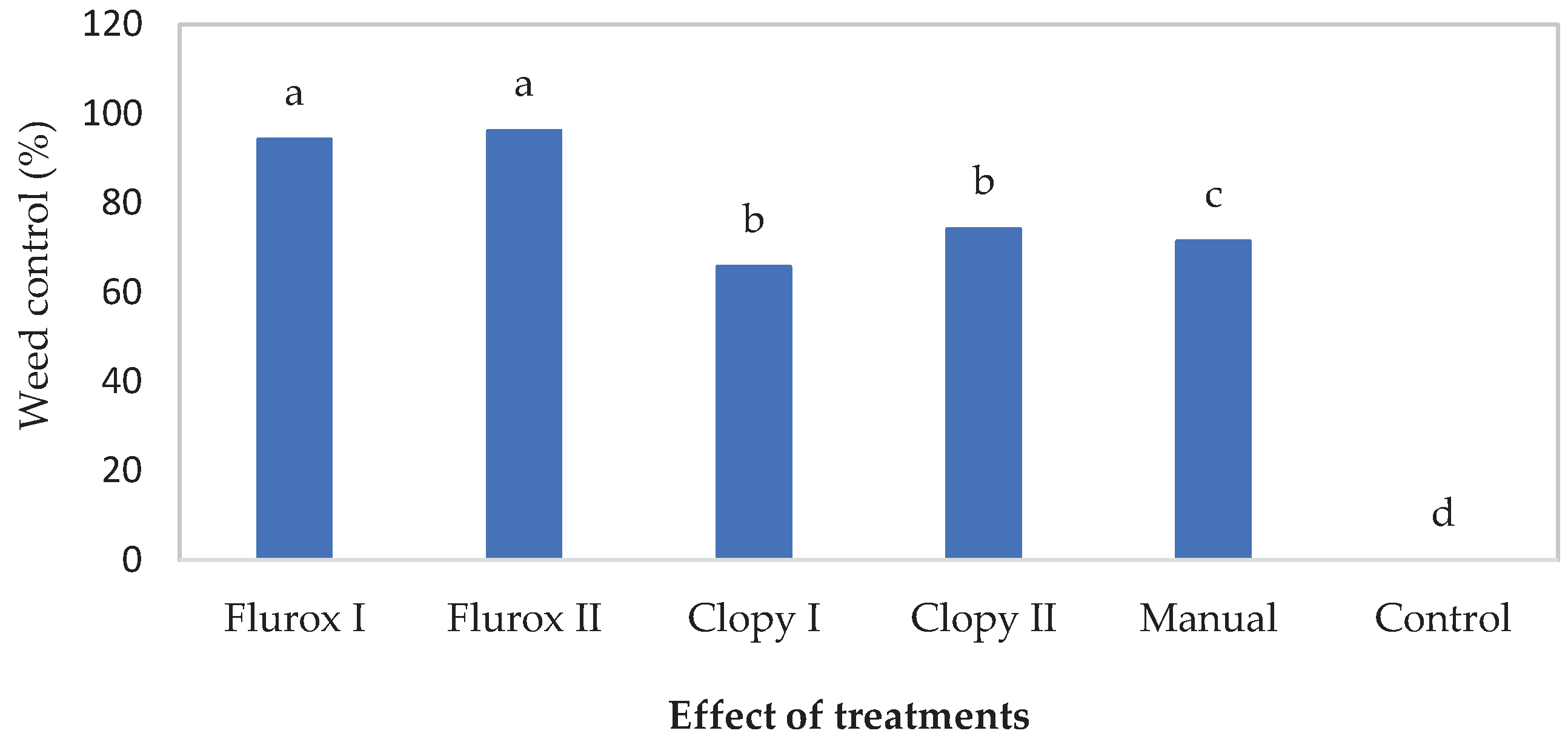
Figure 2.
Efficacy of treatments depending on age of seedlings; Different lower-case letters denote significant differences (p < 0.05) in efficacy among treatments; Flurox I: Fluroxypyr at dose 360 g ai ha-1; Flurox II: Fluroxypyr at dose 540 g a.i. ha-1; Clopy I: Clopyralid at dose 100 g a.i. ha-1; Clopy II: Clopyralid at dose 120 g a.i. ha-1; Manual: Manual weeding.
Figure 2.
Efficacy of treatments depending on age of seedlings; Different lower-case letters denote significant differences (p < 0.05) in efficacy among treatments; Flurox I: Fluroxypyr at dose 360 g ai ha-1; Flurox II: Fluroxypyr at dose 540 g a.i. ha-1; Clopy I: Clopyralid at dose 100 g a.i. ha-1; Clopy II: Clopyralid at dose 120 g a.i. ha-1; Manual: Manual weeding.
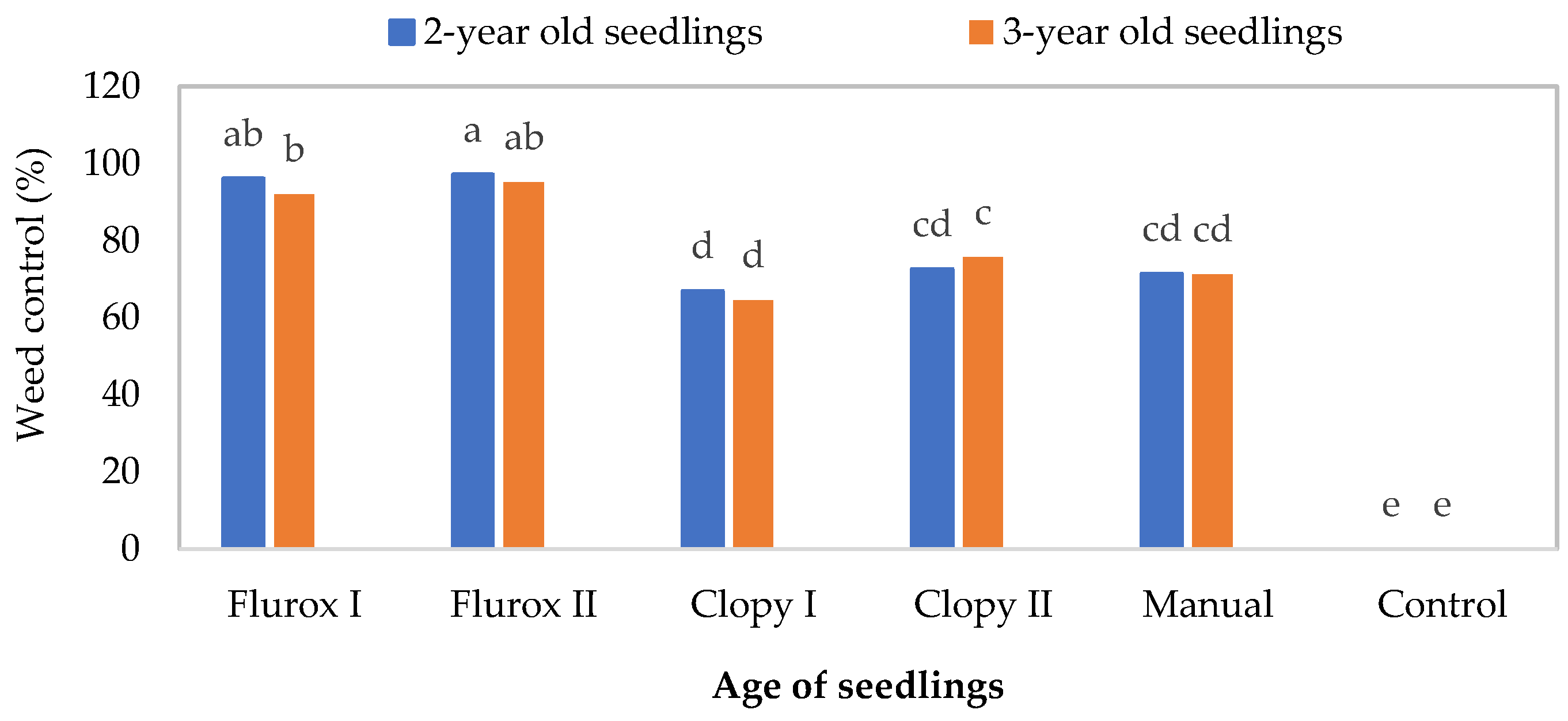
Figure 3.
Efficacy of treatments in Experiment I and Experiment II during the years of investigation; Different lower-case letters denote significant differences (p < 0.05) in efficacy among treatments; Experiment I: 2-year-old oak seedlings; Experiment II: 3-year-old oak seedlings.
Figure 3.
Efficacy of treatments in Experiment I and Experiment II during the years of investigation; Different lower-case letters denote significant differences (p < 0.05) in efficacy among treatments; Experiment I: 2-year-old oak seedlings; Experiment II: 3-year-old oak seedlings.
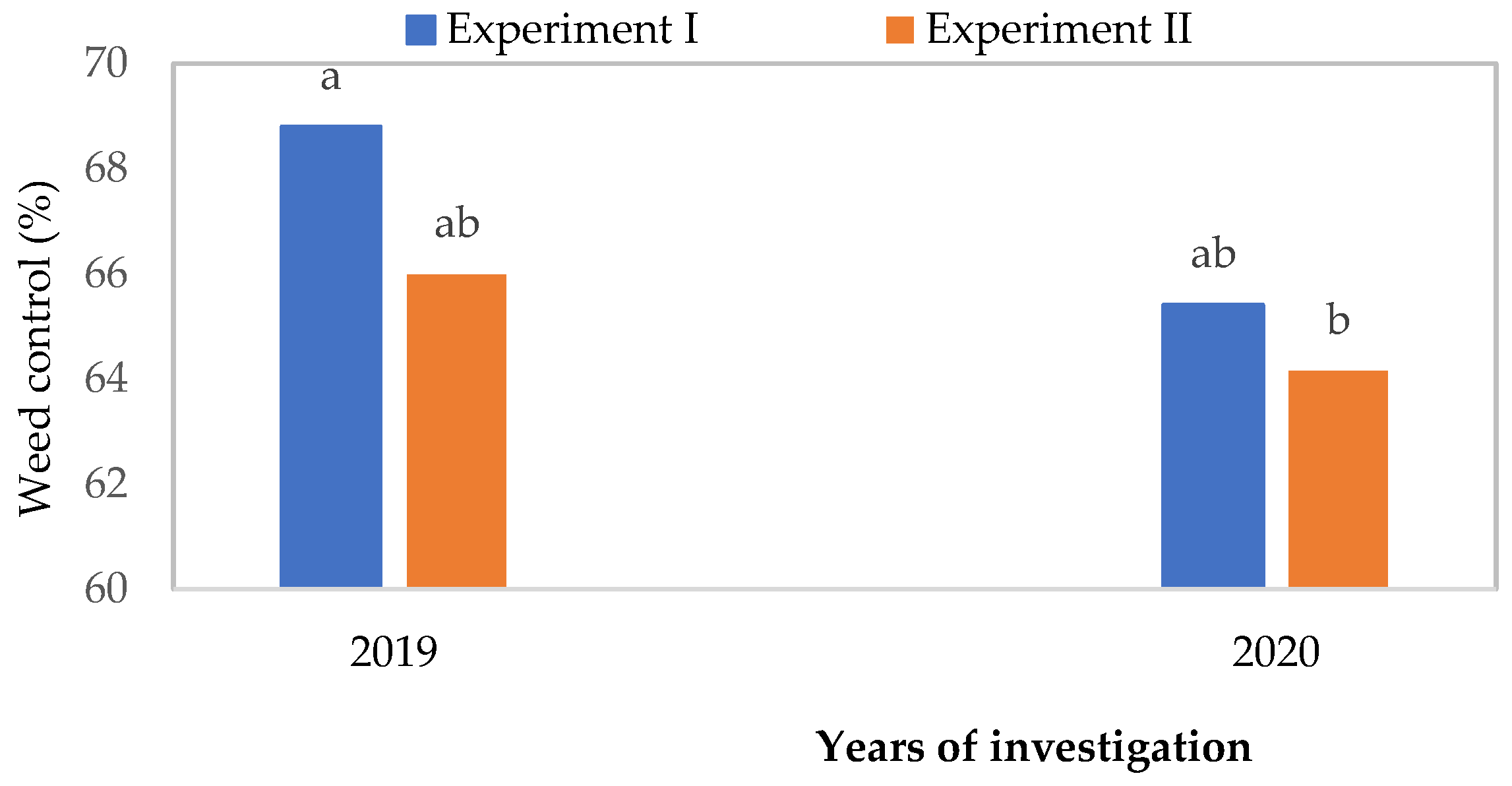
Figure 4.
Efficacy of treatments depending on the time assessment: (a) Efficacy depending on the time assessment—generally observed; (b) Efficacy of treatments at 14, 30, and 45 days; Different lower-case letters denote significant differences (p < 0.05) in efficacy among treatments; Flurox I: Fluroxypyr at dose 360 g ai ha-1; Flurox II: Fluroxypyr at dose 540 g a.i. ha-1; Clopy I: Clopyralid at dose 100 g a.i. ha-1; Clopy II: Clopyralid at dose 120 g a.i. ha-1; Manual: Manual weeding.
Figure 4.
Efficacy of treatments depending on the time assessment: (a) Efficacy depending on the time assessment—generally observed; (b) Efficacy of treatments at 14, 30, and 45 days; Different lower-case letters denote significant differences (p < 0.05) in efficacy among treatments; Flurox I: Fluroxypyr at dose 360 g ai ha-1; Flurox II: Fluroxypyr at dose 540 g a.i. ha-1; Clopy I: Clopyralid at dose 100 g a.i. ha-1; Clopy II: Clopyralid at dose 120 g a.i. ha-1; Manual: Manual weeding.
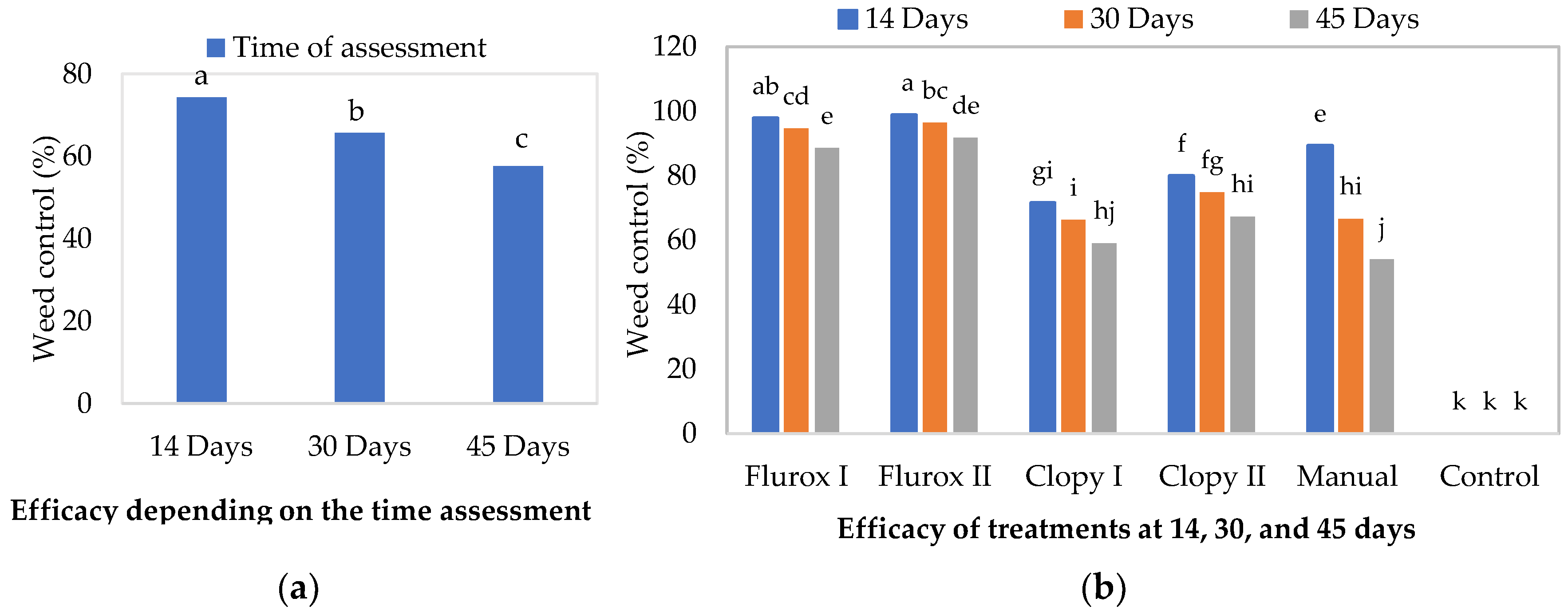
Figure 5.
Fresh broadleaved weed biomass at 45 days after treatments: (a) Fresh weed biomass in Experiment I; (b) Fresh weed biomass in Experiment II; Different lower-case letters denote significant differences (p < 0.05) in efficacy among treatments; Flurox I: Fluroxypyr at dose 360 g a.i. ha-1; Flurox II: Fluroxypyr at dose 540 g a.i. ha-1; Clopy I: Clopyralid at dose 100 g a.i. ha-1; Clopy II: Clopyralid at dose 120 g a.i. ha-1; Manual: Manual weeding.
Figure 5.
Fresh broadleaved weed biomass at 45 days after treatments: (a) Fresh weed biomass in Experiment I; (b) Fresh weed biomass in Experiment II; Different lower-case letters denote significant differences (p < 0.05) in efficacy among treatments; Flurox I: Fluroxypyr at dose 360 g a.i. ha-1; Flurox II: Fluroxypyr at dose 540 g a.i. ha-1; Clopy I: Clopyralid at dose 100 g a.i. ha-1; Clopy II: Clopyralid at dose 120 g a.i. ha-1; Manual: Manual weeding.
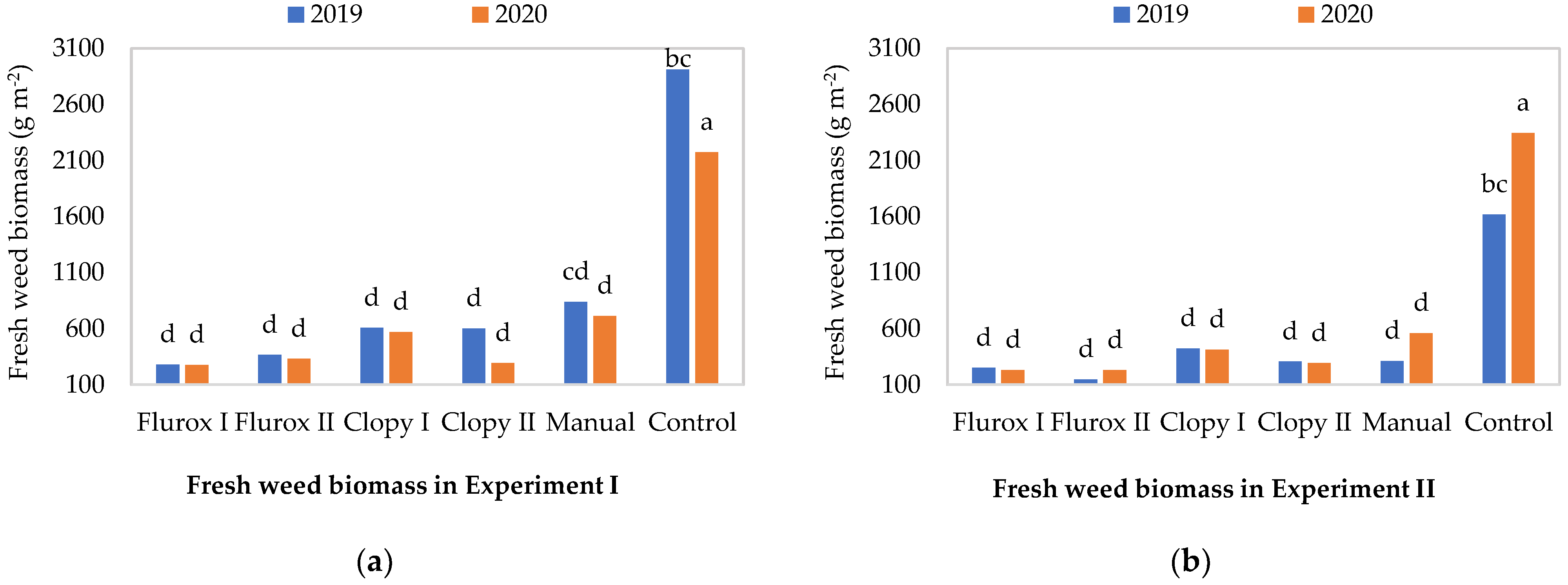
Disclaimer/Publisher’s Note: The statements, opinions and data contained in all publications are solely those of the individual author(s) and contributor(s) and not of MDPI and/or the editor(s). MDPI and/or the editor(s) disclaim responsibility for any injury to people or property resulting from any ideas, methods, instructions or products referred to in the content. |
© 2023 by the authors. Licensee MDPI, Basel, Switzerland. This article is an open access article distributed under the terms and conditions of the Creative Commons Attribution (CC BY) license (https://creativecommons.org/licenses/by/4.0/).
Copyright: This open access article is published under a Creative Commons CC BY 4.0 license, which permit the free download, distribution, and reuse, provided that the author and preprint are cited in any reuse.
MDPI Initiatives
Important Links
© 2024 MDPI (Basel, Switzerland) unless otherwise stated



